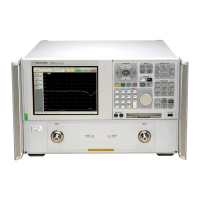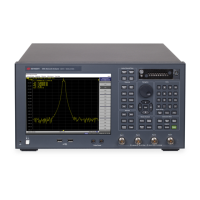Service Guide E8364-90038 3-17
PNA Series Microwave Network Analyzers Tests and Adjustments
E8362C, E8363C, E836C Preliminary Checks
Cable Connector Repeatability Check
NOTE The connector repeatability measurement should be done at the test port as well as at the
end of the test port cable.
1. With the test port cable still connected to Port 1, connect a broadband load to the other end of the cable.
2. Press Preset.
3. On the Channel menu, click Average. In the Average dialog box, click the Average ON check box. In the
Average Factor box, type 100 or click the arrows to select 100. Click OK.
4. Wait for the analyzer to average the measurement 100 times (approximately five seconds).
5. To normalize the data trace:
a. On the Trace menu, click Math/Memory.
b. In the Math/Memory dialog box, click the Data->Memory button.
c. In the Data Math list, select Data/Memory.
d. Under Trace View Options, make sure Data Trace is selected.
e. Click OK
6. To adjust the display scale:
a. On the Scale menu, click Scale.
b. In the Scale Per Division box, click the arrow to select 0.5 dB.
c. In the Level box under Reference click the arrow to select 0 dB.
d. Click OK.
7. Disconnect and then reconnect the cable to the test port. Tighten the connection to the specified torque
for the connector type.
8. On the Channel menu, click Restart Avg.
9. Look at the trace for spikes or modes.
10. To re-normalize the data trace of the reconnected cable:
a. On the Trace menu, click Math/Memory.
b. In the Math/Memory dialog box, click the Data->Memory button.
c. Click OK.
11. Repeat steps 7 through 9 at least three times to look for modes. Modes appear when a harmonic of the
source fundamental frequency is able to propagate through the cable or connector. It is helpful to print a
plot of the trace each time to compare several connections. If any mode appears each time the cable is
connected and reconnected, measurement integrity will be affected.
For a typical response of cable connector repeatability, see Figure 3-7.
12. For the Port 2 Check, connect the cable (with the load attached) to Port 2 and repeat steps 2 through 11.

